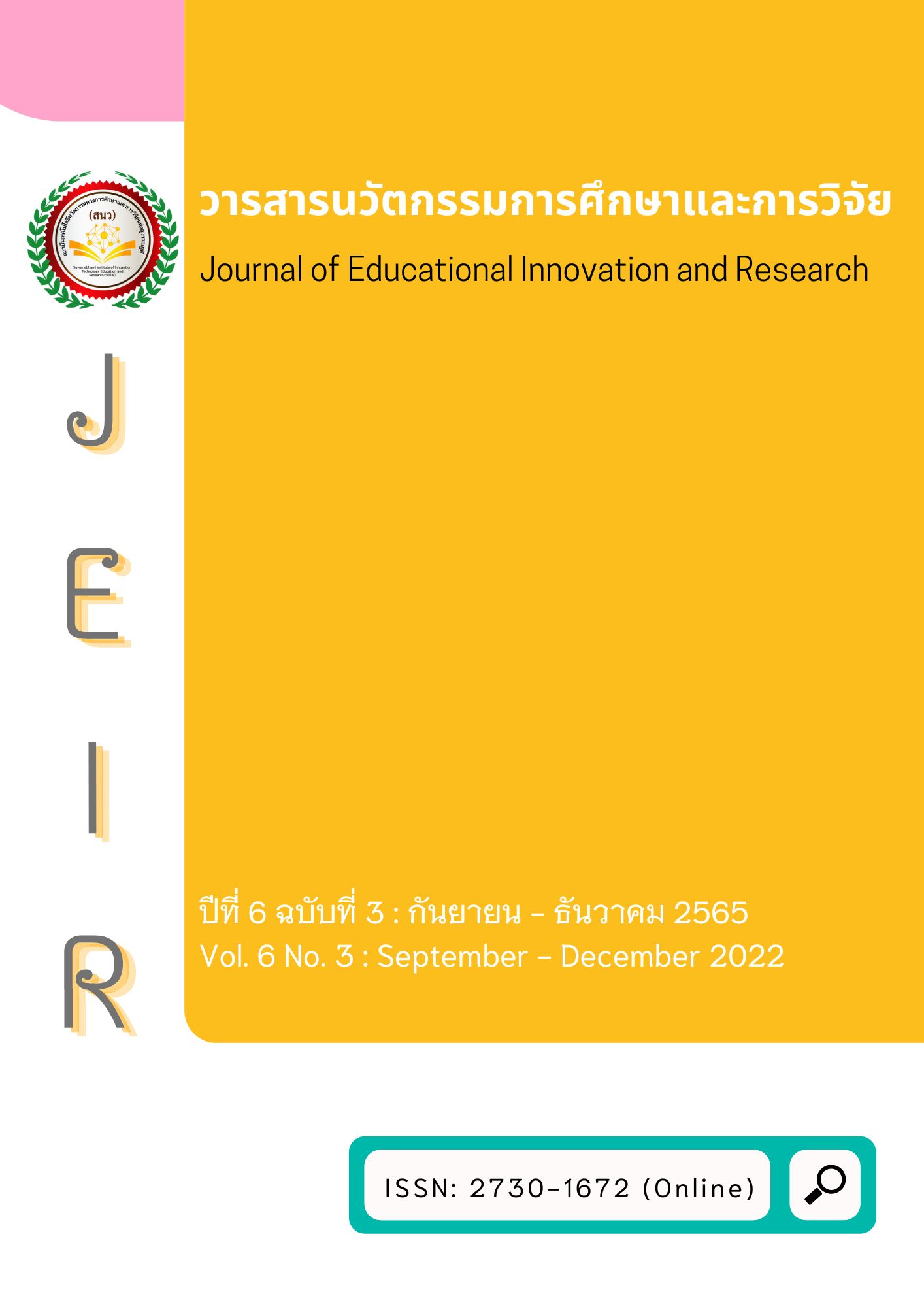การบริหารจัดการในศตวรรษที่ 21 ที่สัมพันธ์กับการใช้นวัตกรรมในสถานศึกษาของโรงเรียนในสังกัดสำนักงานเขตพื้นที่การศึกษามัธยมศึกษาประจวบคีรีขันธ์
Main Article Content
บทคัดย่อ
การวิจัยนี้มีวัตถุประสงค์เพื่อ (1) ศึกษาการบริหารจัดการในศตวรรษที่ 21 (2) ศึกษาการใช้นวัตกรรมในสถานศึกษา และ (3) เพื่อหาความสัมพันธ์ระหว่างการบริหารจัดการในศตวรรษที่ 21
กับการใช้นวัตกรรมในสถานศึกษาของโรงเรียนในสังกัดสำนักงานเขตพื้นที่การศึกษามัธยมศึกษาประจวบคีรีขันธ์ การวิจัยนี้เป็นการวิจัยเชิงปริมาณ กลุ่มตัวอย่าง ได้แก่ ผู้บริหารและครูในสถานศึกษา สังกัดสำนักงานเขตพื้นที่การศึกษามัธยมศึกษาประจวบคีรีขันธ์ จำนวน 292 คน ได้มาโดยการสุ่มกลุ่มตัวอย่างแบบแบ่งชั้น เครื่องมือที่ใช้เป็นแบบสอบถามมาตราส่วนประมาณค่า 5 ระดับ มีค่าความเชื่อมั่นทั้งฉบับเท่ากับ 0.94 สถิติที่ใช้ในการวิเคราะห์ข้อมูล ได้แก่ ร้อยละ ค่าเฉลี่ย ส่วนเบี่ยงเบนมาตรฐาน และการหาค่าสัมประสิทธิ์สหสัมพันธ์เพียร์สัน
ผลการวิจัย (1) การบริหารจัดการในศตวรรษที่ 21 ของโรงเรียนในสังกัดสำนักงานเขตพื้นที่การศึกษามัธยมศึกษาประจวบคีรีขันธ์โดยภาพรวมอยู่ในระดับมาก (2) การใช้นวัตกรรมในสถานศึกษาของโรงเรียนในสังกัดสำนักงานเขตพื้นที่การศึกษามัธยมศึกษาประจวบคีรีขันธ์โดยภาพรวมอยู่ในระดับมาก (3) ความสัมพันธ์ระหว่างการบริหารจัดการในศตวรรษที่ 21 กับการใช้นวัตกรรมในสถานศึกษาของโรงเรียนในสังกัดสำนักงานเขตพื้นที่การศึกษามัธยมศึกษาประจวบคีรีขันธ์ พบว่า มีความสัมพันธ์กันในระดับสูงอย่างมีนัยสำคัญทางสถิติที่ระดับ 0.01
Article Details

อนุญาตภายใต้เงื่อนไข Creative Commons Attribution-NonCommercial-NoDerivatives 4.0 International License.
เอกสารอ้างอิง
กรรณิกา เรดมอนด์. (2559). ตัวบ่งชี้ทักษะภาวะผู้นำในศตวรรษที่ 21 สำหรับผู้บริหารสถานศึกษาขั้นพื้นฐาน (ดุษฎีนิพนธ์ปริญญาดุษฎีบัณฑิต). มหาวิทยาลัยมหามกุฏราชวิทยาลัย.
ณัทชลิดา บุตรดีวงษ์. (2561). การใช้นวัตกรรมและเทคโนโลยีสารสนเทศเพื่อการบริหารสถานศึกษาใน ศตวรรษที่ 21 ของโรงเรียนแสนสุข สำนักงานเขตพื้นที่การศึกษามัธยมศึกษา เขต 18 (วิทยานิพนธ์ศึกษาศาสตรมหาบัณฑิต). มหาวิทยาลัยเกริก.
พิชิต ฤทธิ์จรูญ. (2559). เทคนิคการวิจัยเพื่อพัฒนาการเรียนรู้. กรุงเทพฯ: จุฬาลงกรณ์มหาวิทยาลัย.
แพรดาว สนองผัน. (2557). ทักษะของผู้บริหารสถานศึกษาในศตวรรษที่ 21 สังกัดสำนักงานเขตพื้นที่การศึกษาประถามศึกษาอุดรธานี เขต 3 (วิทยานิพนธ์ปริญญามหาบัณฑิต). มหาวิทยาลัย ขอนแก่น.
ภาณุมาส ควรครู, ชาญวิทย์ หาญรินทร์ และรชฏ สุวรรณกูฏ (2560). การบริหารจัดการในศตวรรษที่ 21 ที่สัมพันธ์กับการใช้นวัตกรรมในสถานศึกษา. วารสารมหาวิทยาลัยนครพนม,7(3), 44-52.
มณฑาทิพย์ นามนุ. (2561). ทักษะของผู้บริหารสถานศึกษาในศตวรรษที่ 21 สังกัดสำนักงานเขตพื้นที่การศึกษาประถามศึกษาปทุมธานี เขต 2 (วิทยานิพนธ์ปริญญามหาบัณฑิต). มหาวิทยาลัยเทคโนโลยีราชมงคลธัญบุรี.
วิจารณ์ พานิช. (2555). การจัดการความรู้กับการบริหารราชการไทย. กรุงเทพฯ: สถานบันส่งเสริม เพื่อสังคม.
วิฑูรย์ สิมะโชคดี. (2541). การบริหารงานแบบคุณภาพ. พิมพ์ครั้งที่ 7. กรุงเทพฯ: เอเชียเพรส.
วิรัช วิรัชนิภาวรรณ. (2549). การพัฒนาเมืองและชนบทประยุกต์. กรุงเทพฯ: ฟอร์เพซ.
ศศิตา เพลินจิต. (2558). ทักษะการบริหารในศตวรรษที่ 21 ของผู้บริหารสถานศึกษาขั้นพื้นฐานสังกัด สำนักงานเขตพื้นที่การศึกษาประถมศึกษานครปฐม เขต 1 (วิทยานิพนธ์ครุศาสตรมหาบัณฑิต). มหาวิทยาลัยราชภัฏกาญจนบุรี.
ศศิรดา แพงไทย (2559). บทบาทของผู้บริหารสถานศึกษาในศตวรรษที่ 21. วารสารวิทยาลัยบัณฑิต เอเชีย,6(1), 7-11.
Bellanca, J., & Brandt, R. (2010). 21st Century skills, rethinking, how students learn. Bloomington, IN: Solution Tree Press.
Driscoll, M. (2015).Top 10 Characteristics of Successful 21st Century School Leaders. Retrieve September 5, 2021, from https://thinkstrategicforschools.com/top-10-characteristics-21st- century-school-leaders/
Gaze, A. (2016). Preparing School Leaders: 21st Century Skills. Retrieved September 8, 2021, from https://www.oecd.org/site/eduistp2012/49850576.pdf
Hoyle, English and Steffy (2005). Skills for Successful 21st Century School Leaders. Retrieved September 8, 2021, from https://files.eric.ed.gov/fulltext/ED420911.pdf
Likert, R. (1967). The method of constructing and attitude scale. New York: Wiley & Son.
Schleicher, A. (2015). School for 21st century learners: Strong leaders, confident teachers, innovative approaches. International Summit on the Teaching Profession, OECD.
Yamane, T. (1970). Statistic: an Introductory Analysis. 2nd ed. New York: Harper & Row.


